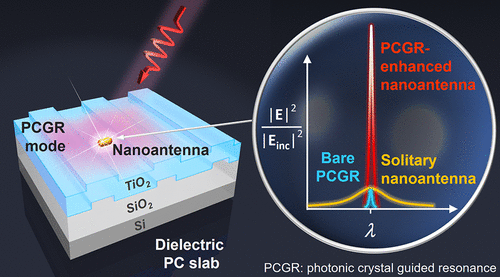当前位置:
X-MOL 学术
›
Nano Lett.
›
论文详情
Our official English website, www.x-mol.net, welcomes your
feedback! (Note: you will need to create a separate account there.)
Nanoantenna–Microcavity Hybrids with Highly Cooperative Plasmonic–Photonic Coupling
Nano Letters ( IF 9.6 ) Pub Date : 2017-11-07 00:00:00 , DOI: 10.1021/acs.nanolett.7b03519 Jui-Nung Liu 1 , Qinglan Huang 1 , Keng-Ku Liu 2 , Srikanth Singamaneni 2 , Brian T. Cunningham 1
Nano Letters ( IF 9.6 ) Pub Date : 2017-11-07 00:00:00 , DOI: 10.1021/acs.nanolett.7b03519 Jui-Nung Liu 1 , Qinglan Huang 1 , Keng-Ku Liu 2 , Srikanth Singamaneni 2 , Brian T. Cunningham 1
Affiliation

|
Nanoantennas offer the ultimate spatial control over light by concentrating optical energy well below the diffraction limit, whereas their quality factor (Q) is constrained by large radiative and dissipative losses. Dielectric microcavities, on the other hand, are capable of generating a high Q-factor through an extended photon storage time but have a diffraction-limited optical mode volume. Here we bridge the two worlds, by studying an exemplary hybrid system integrating plasmonic gold nanorods acting as nanoantennas with an on-resonance dielectric photonic crystal (PC) slab acting as a low-loss microcavity and, more importantly, by synergistically combining their advantages to produce a much stronger local field enhancement than that of the separate entities. To achieve this synergy between the two polar opposite types of nanophotonic resonant elements, we show that it is crucial to coordinate both the dissipative loss of the nanoantenna and the Q-factor of the low-loss cavity. In comparison to the antenna–cavity coupling approach using a Fabry–Perot resonator, which has proved successful for resonant amplification of the antenna’s local field intensity, we theoretically and experimentally show that coupling to a modest-Q PC guided resonance can produce a greater amplification by at least an order of magnitude. The synergistic nanoantenna–microcavity hybrid strategy opens new opportunities for further enhancing nanoscale light–matter interactions to benefit numerous areas such as nonlinear optics, nanolasers, plasmonic hot carrier technology, and surface-enhanced Raman and infrared absorption spectroscopies.
中文翻译:

具有高度协作的等离子-光子耦合的纳米天线-微腔混合器。
纳米天线通过集中远低于衍射极限的光能来提供对光的最终空间控制,而它们的品质因数(Q)受较大的辐射和耗散损耗约束。另一方面,介电微腔能够产生高Q通过延长的光子存储时间来实现高光子吸收系数,但是具有衍射受限的光学模式体积。在这里,我们通过研究一个示例性的混合系统来弥合这两个世界,该系统将充当纳米天线的等离激元金纳米棒与充当低损耗微腔的共振介电光子晶体(PC)平板集成在一起,更重要的是,通过将它们的优点协同地结合起来,产生比单独实体强得多的局部场增强效果。为了在两种极性相反的纳米光子共振元件之间实现这种协同作用,我们证明了协调纳米天线和Q的耗散损耗至关重要损耗腔的系数。与使用Fabry-Perot谐振器的天线-腔耦合方法相比,该方法已被证明可以成功地放大天线的局部场强,我们在理论和实验上表明,耦合至适度Q PC引导的谐振可以产生更大的放大率。至少增加一个数量级 协同的纳米天线-微腔混合策略为进一步增强纳米级的光-质相互作用提供了新的机遇,从而使许多领域受益,例如非线性光学,纳米激光,等离子体热载流子技术以及表面增强拉曼光谱和红外吸收光谱学。
更新日期:2017-11-08
中文翻译:

具有高度协作的等离子-光子耦合的纳米天线-微腔混合器。
纳米天线通过集中远低于衍射极限的光能来提供对光的最终空间控制,而它们的品质因数(Q)受较大的辐射和耗散损耗约束。另一方面,介电微腔能够产生高Q通过延长的光子存储时间来实现高光子吸收系数,但是具有衍射受限的光学模式体积。在这里,我们通过研究一个示例性的混合系统来弥合这两个世界,该系统将充当纳米天线的等离激元金纳米棒与充当低损耗微腔的共振介电光子晶体(PC)平板集成在一起,更重要的是,通过将它们的优点协同地结合起来,产生比单独实体强得多的局部场增强效果。为了在两种极性相反的纳米光子共振元件之间实现这种协同作用,我们证明了协调纳米天线和Q的耗散损耗至关重要损耗腔的系数。与使用Fabry-Perot谐振器的天线-腔耦合方法相比,该方法已被证明可以成功地放大天线的局部场强,我们在理论和实验上表明,耦合至适度Q PC引导的谐振可以产生更大的放大率。至少增加一个数量级 协同的纳米天线-微腔混合策略为进一步增强纳米级的光-质相互作用提供了新的机遇,从而使许多领域受益,例如非线性光学,纳米激光,等离子体热载流子技术以及表面增强拉曼光谱和红外吸收光谱学。











































 京公网安备 11010802027423号
京公网安备 11010802027423号